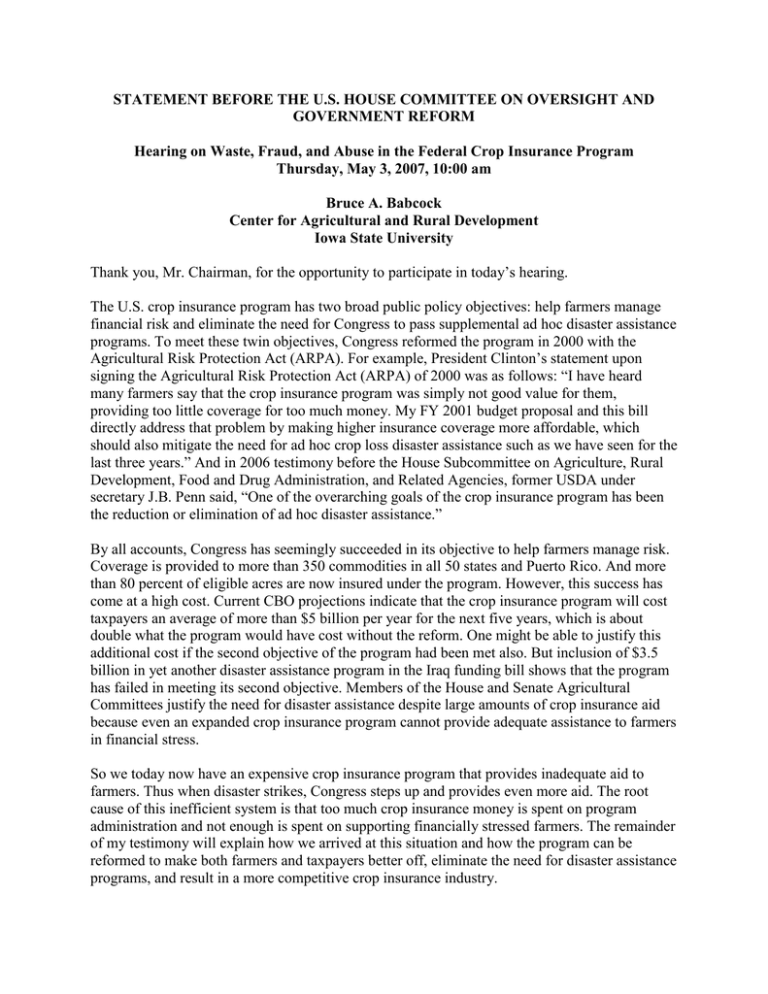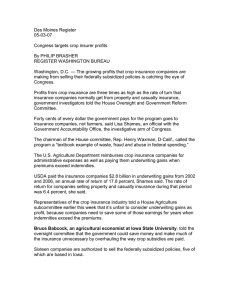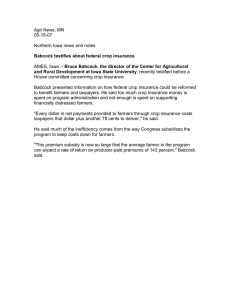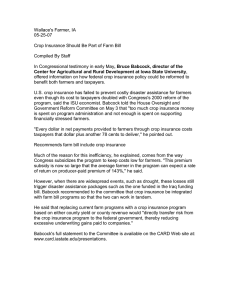STATEMENT BEFORE THE U.S. HOUSE COMMITTEE ON OVERSIGHT AND GOVERNMENT REFORM
advertisement

STATEMENT BEFORE THE U.S. HOUSE COMMITTEE ON OVERSIGHT AND GOVERNMENT REFORM Hearing on Waste, Fraud, and Abuse in the Federal Crop Insurance Program Thursday, May 3, 2007, 10:00 am Bruce A. Babcock Center for Agricultural and Rural Development Iowa State University Tha nky ou,Mr .Cha i r ma n,f ort heoppor t uni t yt opa r t i c i pa t ei nt oda y ’ she a r i ng . The U.S. crop insurance program has two broad public policy objectives: help farmers manage financial risk and eliminate the need for Congress to pass supplemental ad hoc disaster assistance programs. To meet these twin objectives, Congress reformed the program in 2000 with the Agr i c ul t ur a lRi s kPr ot e c t i onAc t( ARPA) .Fore xa mpl e ,Pr e s i de ntCl i nt on’ ss t a t e me ntupon signing the Agricultural Risk Protection Act (ARPA)of2000wa sa sf ol l ows :“ Iha vehe a r d many farmers say that the crop insurance program was simply not good value for them, providing too little coverage for too much money. My FY 2001 budget proposal and this bill directly address that problem by making higher insurance coverage more affordable, which should also mitigate the need for ad hoc crop loss disaster assistance such as we have seen for the l a s tt hr e ey e a r s . ”Andi n2006t e s t i monybe f or et heHous eSubc ommi t t e eonAgr i c ul t ur e ,Rur a l Development, Food and Drug Administration, and Related Agencies, former USDA under s e c r e t a r yJ . B.Pe nns a i d,“ Oneoft heove r a r c hi ngg oa l soft hec r opi ns ur a nc epr og r a m ha sbe e n t her e duc t i onore l i mi na t i onofa dhocdi s a s t e ra s s i s t a nc e . ” By all accounts, Congress has seemingly succeeded in its objective to help farmers manage risk. Coverage is provided to more than 350 commodities in all 50 states and Puerto Rico. And more than 80 percent of eligible acres are now insured under the program. However, this success has come at a high cost. Current CBO projections indicate that the crop insurance program will cost taxpayers an average of more than $5 billion per year for the next five years, which is about double what the program would have cost without the reform. One might be able to justify this additional cost if the second objective of the program had been met also. But inclusion of $3.5 billion in yet another disaster assistance program in the Iraq funding bill shows that the program has failed in meeting its second objective. Members of the House and Senate Agricultural Committees justify the need for disaster assistance despite large amounts of crop insurance aid because even an expanded crop insurance program cannot provide adequate assistance to farmers in financial stress. So we today now have an expensive crop insurance program that provides inadequate aid to farmers. Thus when disaster strikes, Congress steps up and provides even more aid. The root cause of this inefficient system is that too much crop insurance money is spent on program administration and not enough is spent on supporting financially stressed farmers. The remainder of my testimony will explain how we arrived at this situation and how the program can be reformed to make both farmers and taxpayers better off, eliminate the need for disaster assistance programs, and result in a more competitive crop insurance industry. Taxpayer Support of Crop Insurance Since 2001, when the provisions of the Agricultural Risk Protection Act (ARPA) fully came into force, taxpayers have paid $18.7 billion to deliver $10.5 billion in net payments (indemnities paid less farm-paid premiums) to farmers. That is, every dollar in net payments provided to farmers costs taxpayers that dollar plus another 78 cents to deliver. Table 1 provides summary program information since 2001. Taxpayer costs equal Administrative and Operating (A&O) subsidies plus net underwriting gains paid to crop insurance providers plus total indemnities paid to farmers minus farmer-paid premiums. Each of these is discussed in turn. Table 1. National crop insurance data Insured Acreage Total (million Premiums Total acres) Year (million $) Indemnities 2001 211 2,962 2,960 2002 214 2,916 4,067 2003 217 3,431 3,259 2004 221 4,186 3,207 2005 246 3,949 2,351 2006a 242 4,362 3,415 a As reported by RMA as of April 23, 2007. b Estimated from year-to-date loss ratio. Premium Subsidies (million $) 1,772 1,741 2,042 2,477 2,344 2,680 A&O Subsidies 626 743 859 869 861 903 Underwriting Gains 342 -52 378 848 870 908b Administrative and Operating Subsidies It costs money to deliver crop insurance. Company salaries must be paid. Agent commissions must be paid. Loss claims must be verified and paid. And regulatory requirements must be met. In 1980, Congress decided that delivery of the crop insurance program should be given to the private sector so that the program could be expanded as rapidly as possible. Companies had an incentive to expand sales because they were essentially paid a sales commission. For each dollar of premium they brought in, companies were given a percentage. Currently companies are paid A&O subsidies equal to about 20.7 percent of total premium. In 2007, total premium may top $5 billion because of high crop prices, which translates into more than $1.04 billion in A&O payments. By far the largest expense item covered by A&O is agent commissions. Commissions va r ydr a ma t i c a l l ya c r os sa ge nt sde pe ndi ngonhowa t t r a c t i vea na g e nt ’ sc us t ome r sa r et o competing crop insurance companies. Agents that have a book of business (their customer base) that generates fewer insurance claims than premium dollars will typically be paid a higher commission percentage than agents who have less attractive books of business. Thus commission rates in the Corn Belt are typically much greater than they are in Texas or North Dakota. Many Corn Belt agents are paid more than 20 percent for each dollar of premium they bring to a company. Companies can afford these high commission rates in the Corn Belt because Corn Belt policies pay out much less than they generate in premiums. That is, companies obtain the bulk of their underwriting gains from Corn Belt farmers. The best way to think about how agent commissions are determined is with a simple equation: Commission = A&O plus Underwriting Gain minus Other Costs 2 Thus, if underwriting gains are 15 percent, A&O is 20 percent, and other costs (loss adjustment costs, salaries, compliance costs, etc.) total 15 percent, then the commission rate will total 20 percent. If underwriting gains drop to 5 percent, the commission rate drops to 10 percent. The crop insurance industry argues that they could not cover their costs with lower A&O subsidies or lower underwriting gains. This argument is misleading because it does not account for the relationship between commissions and taxpayer support shown in the above equation. Thei ndus t r y ’ snumbe ronec os t —agent commissions—would immediately drop as soon as either A&O or underwriting gains were decreased. This shows that crop insurance agents likely rival farmers as the primary beneficiary of taxpayer support for the crop insurance industry. Net Underwriting Gains As mentioned above, variations in agent commissions are largely determined by the profits companies believe they can make from different agents books of business. Profits are generated in years in which premiums exceed insurance claims. In these years crop insurance companies get to keep a portion of the difference, which is known as an underwriting gain. For example, in 2004, premiums exceeded claims by $979 million. Companies were allowed to keep $848 million of this difference. In years in which premiums are less than insurance claims, companies may have to pay a portion of the difference, an underwriting loss. In 2002, for example, claims exceeded premiums by $1.15 billion. Companies had to pay the government $52 million of this amount. The 2002 and 2004 examples nicely illustrate why, on average, crop insurance companies generate additional funding to bid up agent commissions activities. In years in which underwriting gains are positive, companies get to keep a larger proportion of the gain than they have to pay the government in years in which there are underwriting losses. The mechanism by which net gains and losses are determined is the Standard Reinsurance Agreement (SRA). Companies generate net gains from the SRA in two ways. The first is by determining which of their customers are most likely to generate claims and then giving the premium from these customers and responsibility for any subsequent losses directly to the government. The average customer retained by a company therefore has a better risk profile than does the average customer in the overall pool. Thus, average claims from the retained pool will be lower than the overall average, and the company will tend to make money. However, the overall risk of loss from retained customers is still too large for companies to be willing to take on all losses. Hence the SRA is designed to have the government take on a portion of company losses when claims exceed premiums in exchange for companies giving the government some of their gains when premiums exceed claims. In exchange for companies taking on some of the risk of the crop insurance program, the government is allowing companies to generate some gains. It is almost as if crop insurance companies are selling taxpayers an insurance policy. In years where crop losses are high, taxpayer losses are reduced because some oft hel os s e sa r ec ove r e dbyt he“ pol i c y . ”Thepr e mi um t hat taxpayers pay for this policy are the underwriting gains that companies garner in years where crop losses are small. Whether taxpayers are getting a good deal by this bargain depends on the size of the premium paid in good years relative to the payments received in bad years. Table 2 summarizes one set of conservative estimates of the potential gains and losses to private crop insurance companies from operation of the current SRA. These estimates are based on loss experience from 1993 to 2005 and likely understate the actual underwriting gains that companies currently expect to make. The table presents four equally likely scenarios regarding 3 crop insurance claims. With $4 billion in premiums, companies should expect to make $425 million per year in net underwriting gains. In exchange for paying companies an average of $435 million per year, taxpayers reduce their loss exposure by $223 million in one year out of four. I doubt that there are many taxpayers who would choose such an insurance policy in their own lives. It seems that program costs would be much lower if the Federal government simply and directly took all the risk from the crop insurance program rather than buying an over-priced insurance policy from the crop insurance companies. The conditions under which this conclusion is valid are discussed later. Table 2. Potential gains and losses to crop insurance companies under the Standard Reinsurance Agreement Insurance Claim Scenario Very Low Moderately Low Moderately High Very High Average Loss Ratio (Indemnity over Premium) 0.53 0.72 0.76 1.28 0.82 Ratio of Gain to Total Premium 0.238 0.136 0.115 -0.055 0.108 Total Gain to Companies ($ million) 953 546 462 -223 435 Producer Premium Subsidies The last taxpayer cost category is premium subsidy. Farmers must pay for crop insurance, but they pay only a portion of the amount needed to cover insured losses. Throughout the 1980s and 1990s, farmers were reluctant to buy enough crop insurance to satisfy Congress. So to get farmers to buy more insurance, ARPA dramatically decreased the portion that farmers must pay. Currently, farmers pay about 41 percent of the amount needed to cover insured losses. This large subsidy means that most farmers will get substantially more back from the program than they pay it. It is somewhat of a paradox why farmers require such large subsidies to buy a product that substantially reduces their financial risk. But farmers routinely reduce financial risk in a number of other ways. Growing more than a single crop, raising livestock, working off-farm, employing marketing tools, and adopting risk-reducing management practices—all work to reduce financial vulnerability. In addition, for the lowest-risk farmers, the price of crop insurance may not adequately reflect their risk. So one explanation for this paradox is that for many farmers, the amount of remaining financial risk they face may simply be too small to insure unless the price of insurance is low enough. The current 59 percent average subsidy seems to have reduced the price of insurance to the point where most farmers now consider it worthwhile to purchase. This premium subsidy is now so large that the average farmer in the program can expect a rate of return on producer paid premium of 143 percent. Reducing Costs The high costs of crop insurance are a direct result of Congressional decisions made in 2000. Farmers, agents, and companies have simply responded to the incentives created by ARPA. The hope in 2000 was that by spending more money Congress could save money by not having to pass periodic disaster assistance. But now we have both and it is obvious that the efficiency with which taxpayer money is being used can be dramatically increased through reform of the program. 4 But waste cannot be reduced by simply reducing underwriting gains or A&O reimbursements. One advantage that is often overlooked in giving crop insurance companies a share of the underwriting gains is that provision gives the companies an added incentive to guard against fraudulent claims. After all, it is costly to verify every loss claim and without vigilance, excessive claims will be filed. Because companies must share in the payment of fraudulent claims, they will have some incentive to combat fraud. Guarding against excessive claims is required because most crop insurance policies cover against crop or revenue losses at the farm level. But, for most crop insurance policies, when one farm has a loss in a region, other farmers in the same region also suffer a loss. This correlation of losses among farmers is because crop insurance claims are most often triggered by systemic events. Examples of systemic events include widespread drought, low farm prices, or excessive heat. Note that these events are also the events that trigger disaster assistance packages in Congress. This coincidence suggests a path that Congress could take to end waste in the crop insurance program while eliminating the need for disaster assistance programs. This path would be for Congress to integrate crop insurance with farm bill programs so that the two work in tandem with each other rather. This could be done by using replacing current farm programs with one of two crop insurance programs: Group Risk Plan (GRP), which pays out when county yield is low, or Group Risk Income Protection (GRIP), which pays out when county revenue is low. Adoption of GRIP would also protect farmers against unanticipated declines in prices. Analysis has shown that adoption of either of these programs would directly transfer risk from the crop insurance program to the Federal government thereby reducing excessive underwriting gains paid to companies. Because losses would be paid out based on county yields, the need for costly verification of farm yields would be avoided. Because such a program would automatically make payments when regional disasters occur, it would serve as a standing disaster program. There would still be a role for private crop insurance to the extent that farmers were willing to pay for insurance against the risk of losses that would not be covered by the farm bill program. These losses would largely be insurable losses because the uninsurable systemic losses would be covered by the farm bill programs. If market demand were sufficient, then a private, competitive crop insurance industry could emerge that would supplement the risk management assistance offered by the farm bill. This type of integrated approach would make the best use of public funds. 5




